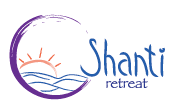Archive
Asana of the Week with Tiina Veer from Yoga for Round Bodies
Supta Bada Konasana (Reclining Bound Angle Pose)
Supta Bada Konasana is a jewel from Restorative Yoga that I like to include in Restorative classes, as well as in longer Hatha classes for an opening guided relaxation.
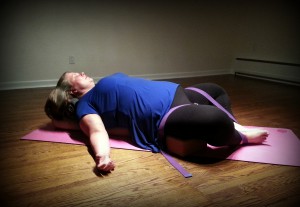
Supta Bada Konasana has many benefits — don’t be fooled by its soft appearance! There is so much going on. Because I’m an anatomy geek, let me share with you some of the effects I find anatomically magical, among a few others:
• Possibly my favourite effect is what happens due to the unique supported leg position: with hips and knees in flexion, and hips in supported abduction (i.e., out to the sides on blocks, no stretch in the groin), and with the pelvis slightly tipped forward by the bolster behind the back, all the muscles that usually pull on the pelvis are slackened. This allows the pelvis to relax into a slackened sling, and be guided into alignment by the structure of the props. It’s awesome: the psoas, QL’s, erector spinae, quads, hams, gluts, adductors—even piriformis!—are all slackened.
Coupled with the feet together and bound, the legs stay aligned, thus allowing the pelvis to find alignment between the femurs.
• The chest is pressed open to the sky by the bolster behind the back, the weight of the free arms pulling the shoulders to the ground. Because this can often be held for minutes by beginners, and 15 or 20 minutes by more experienced practitioners, connective tissue across the chest and anterior shoulders can be gently but effectively lengthened. It’s also a great position to explore all the movements of the ribcage when breathing, and on deep breathing, a great way to stretch open the muscles and sinews between and around the ribs. This open-hearted position is also used in yoga therapy to treat depression and heart conditions.
• The position of the neck on a high support (here a chunky folded blanket), with the chin coming toward the throat, gently lengthens the back of the neck. When held for minutes at a time, it can have a significant effect on the often shortened connective tissue there (major cause of tension headaches). This position also bows the forehead to the chest, a symbolic way to surrender the ego and honour the greater wisdom of the heart, and is also a meditation technique used to calm the mind.
This pose, like so many others in Restorative Yoga, also helps us to challenge our need to constantly do.
So often we need to spend time undoing before doing. As a teacher, I love it for its many benefits and because it’s so beginner-friendly. As a practitioner, I love it because it feels like coming home.
Tiina Veer
Yoga for Round Bodies Retreat
Aug 16-18, 2013
Date Added: August 23, 2013 | Comments (0) | Filed under: Living with Yoga
Asana of the Week with Kellie Dearman – Navasana
Navasana (Boat Pose)
I teach boat pose as a way of building core strength to my students of all levels. I particularly love poses that you can use for beginners and that can easily be adapted for more advanced practitioners. For beginners this pose helps to build awareness of the abdominal, back and hip flexor muscles. I start from a regular bent-leg seated position with hands holding onto the backs of thighs. To begin, raise bent legs while maintaining hold on thighs. Move your weight backwards over the sacrum and until you find the spot to balance upon with lower legs parallel to the floor. Begin to explore the muscles and strength required to hold in this position. Release the hold on one leg, and then the other if possible, and position the arms in a line parallel to the floor. Keep the abdominal floor firm and gently broaden through the heart and chest, relaxing the shoulders and neck tension. Maintain a firm and strong spine but let the head rest gently in alignment with the rest of the spine. Use breath to release any tension building in the shoulders. Breathe deeply throughout the hold. With practice lengthen the amount of time.
When sufficient strength has developed, begin to practice this pose with legs extended in a straight line, about a 45-degree angle with the floor. Match that angle with the torso. For more challenge, extend the arms up overhead, in line with the spine.
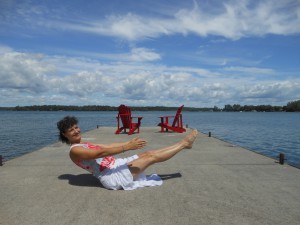
Benefits
Builds strength in the abdominal, hip flexors and spine
Stimulates internal organs, particularly kidneys and intestines
Improves digestion
Calming, stress relieving
Contraindications
Any issues with digestive track or lungs that are aggravated by squeezing of internal organs
Neck injuries or headaches if exascerbated
Low blood pressure
If tailbone is bruised or sensitive, a variation of this pose can be explore while resting on forearms, but watch for added pressure in back of neck.
Bio
Kellie Dearman teaches Gentle Hatha Yoga in a style adaptable to all ages and abilities. She runs Aware Yoga studio from her home in Stirling, Ontario and also
teaches many classes of Yoga for Older Adults for the City of Belleville
Aware Yoga on Facebook
Date Added: August 14, 2013 | Comments (0) | Filed under: Living with Yoga
Best Brownies Ever….Note: may contain butternut squash
So many recipes are always being posted on all forms of social media. I am always tempted to try the recipes based on whole, nutrient dense foods. When I saw this brownie recipe, I knew it was a must! We then of course adapted it to suit our pantry needs and personal preferences. The result…the best brownies ever. This may have been one of our most popular desserts at Shanti Retreat. The guests were dying for the recipe….and for more brownies! Be careful though, they are so good you may possibly eat 6…at one sitting…Enjoy.
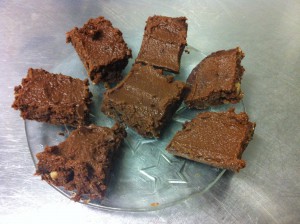
Dry:
½ cup spelt flour (or buckwheat for GF version)
½ cup cacao powder
2 Tbsp arrowroot powder (only used this for the GF version and ommmited for Spelt flour version)
1 cup organic raw sugar
¼ tsp sea salt
¼ tsp baking powder
Wet:
½ cup butternut squash puree
⅓ cup coconut oil
2 eggs (2 flax eggs for Vegan Version – 2 tbsp ground flax + 4 tbsp warm water- let sit for 5 minutes)
1.5 tsp vanilla vanilla extract
1 cup walnuts
½ cup chocolate chips (gluten free) or good quality dark chocolate chopped into little pieces
Frosting:
½ cup butternut squash puree
¼ cup coconut oil, melted
¼ cup raw honey, local if possible
2 Tbsp raw cacao powder
1.5 tsp vanilla extract
How to make:
Preheat oven to 350F.
Peel butternut squash with a vegetable peeler or sharp knife. Cut into little 2 cm cubes and steam for 10 minutes. Put into food processor and puree until smooth.
In a large bowl mix together flour, cacao powder, arrowroot powder (if using), sugar, sea salt and baking powder.
In a medium bowl whisk together eggs (or flax egg), ½ cup squash puree, coconut oil and vanilla extract.
Chop walnuts into little pieces.
Combine the wet ingredients into dry and add chocolate chips and walnuts. Mix well.
Grease a baking dish and pour in batter. Spread with a spatula or your hands until uniform on top.
Bake for 20-25 minutes.
To make the frosting combine all ingredients and mix well. Spread frosting on brownie when you take it out of the oven, then refrigerate the brownies for an hour or so before eating.
Serves 12
Date Added: August 7, 2013 | Comments (0) | Filed under: Shanti Kitchen
Asana of the week with Andrea Robertson: Urdhva Mukha Svanasana
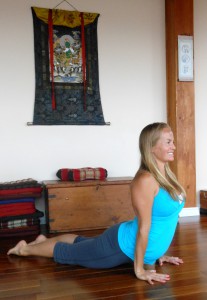 Upward Facing Dog/Urdhva Mukha Svanasana
Upward Facing Dog/Urdhva Mukha Svanasana
Aside from downward dog, upwardog facing dog is one of the most widely known and recognized yoga poses due to its numerous benefits and therapeutic uses. As cousin to the Cobra pose, it is considered one of the routine poses during the Sun Salutaion series.
Consistant and determined practice of upardog facing dog, as well as other back bends done yoga practices can
- Strengthen the spine, arms and wrists
- Stimulate the organs of the abdomen
- Improve posture, by stretching anterior spine and strengthening posterior spine
- Stretch chest and lungs, shoulders and abdomen
- Helps to relieve depression, fatigue and pain of sciatica
- Increase lung capacity to relieve the symptoms of asthma
Poses like this are critical for a healthy back, especially with so many of our daily postures and chores that induce the forward fold of the torso. When we are forward all day-whether sitting at our desks or driving for hours on end, we over stretch our back muscles and weaken our abdominals.
Back-bending poses like upward counteract this growing problem. Once we are in better more lifted postures, it automatically puts our abdominal organs in a better functioning position. It is also a great pose to tone our arms and legs and open our hearts.
Mid-Week Retreat with Andrea Robertson
July 31st- August 1, 2013
www.animar.ca
www.bodyandbalance.ca
Date Added: August 5, 2013 | Comments (0) | Filed under: Living with Yoga











